|
Genus: Accipiter (sparrowhawks
and goshawks)
Life
> Eukaryotes >
Opisthokonta
> Metazoa (animals) >
Bilateria >
Deuterostomia > Chordata >
Craniata > Vertebrata (vertebrates) > Gnathostomata (jawed
vertebrates) > Teleostomi (teleost fish) > Osteichthyes (bony fish) > Class:
Sarcopterygii (lobe-finned
fish) > Stegocephalia (terrestrial
vertebrates) > Tetrapoda
(four-legged vertebrates) > Reptiliomorpha > Amniota >
Reptilia (reptiles) >
Romeriida > Diapsida > Archosauromorpha > Archosauria >
Dinosauria
(dinosaurs) > Saurischia > Theropoda (bipedal predatory dinosaurs) >
Coelurosauria > Maniraptora > Aves
(birds) > Order: Falconiformes
> Family: Accipitridae
Distributed worldwide (except Antarctica) with six
of the 54 species found in southern Africa.
Species indigenous to southern Africa
|
Accipiter badius (Shikra,
Little banded goshawk)
Distributed through southern Asia, the Arabian
Peninsula and sub-Saharan Africa. Found in open and closed woodlands,
including in open semi-arid savanna. Lizards are the main item in its diet
but it also eats insects, small birds, and more occasionally bats, rodents
and frogs.
|
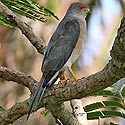 |
|
Accipiter melanoleucus
(Black
sparrowhawk)
|
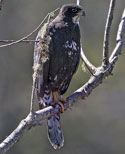 |
|
Accipiter minullus (Little
sparrowhawk)
Occurs in central, east and southern Africa in, and
on the border of, wooded habitats such as forest, woodland, thicket and
alien trees. Preys mainly on small birds (up to the size of doves) but
also attacks small mammals (rodents, bats), lizards and
insects.
|
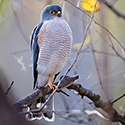 |
|
Accipiter ovampensis (Ovambo
sparrowhawk)
|
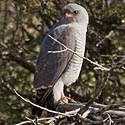 |
|
Accipiter rufiventris
(Rufous-chested sparrowhawk, Red-breasted sparrowhawk)
|
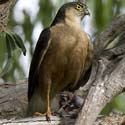 |
|
Accipiter tachiro (African
goshawk)
Widely distributed in Africa south of the Sahara in
woodland, forest, alien plantations and wooded urban areas. Makes its
presence known in an area by taking early morning flights high above the
ground and emitting its clicking call (like two stones hit together at 2-3
second intervals). Preys mainly on birds (up to the size of francolins and
domestic chickens and including nestlings) but also on small mammals
(bats, squirrels, mice) and lizards. More rarely feeds on snakes, frogs,
earthworms and insects.
|
 |
|
